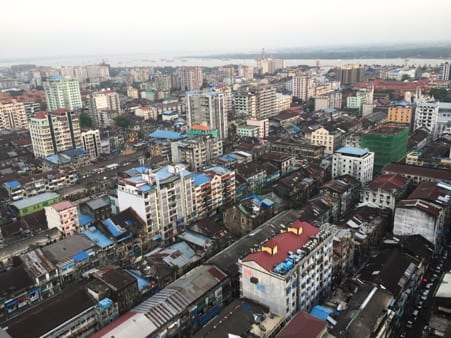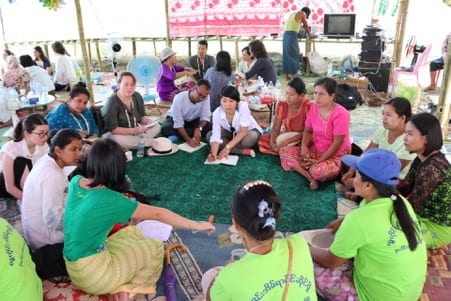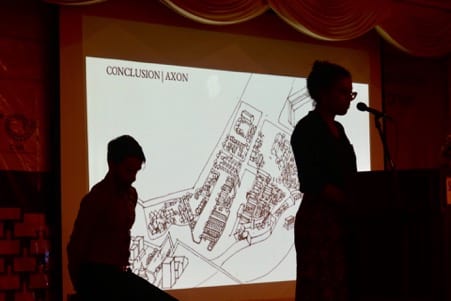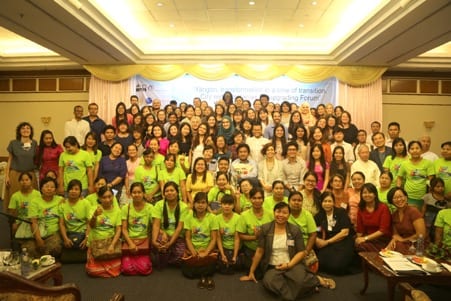Yangon: Transformation in a Time of Transition – BUDD Fieldtrip 2017
By ucfurim, on 19 May 2017
In the late hours of November 8th 2015 it was clear that Aung San Suu Kyi, leader of the National League for Democracy and Nobel Peace Prize winner, had scored an unquestionable electoral triumph. After decades of military rule, the NLD categorically won Myanmar’s latest elections, gaining control of parliament and thus starting a new chapter in the country’s turbulent political history. The ensuing months, however, have been far from perfect, with repeated tensions and confrontations that expose Myanmar’s deeply rooted problems with religious tolerance, ethnic integration, displacement and migration. In a momentous time of transition, the country’s transformation towards democracy, growth and aperture faces innumerable challenges –a reality that is particularly evident in Yangon, Myanmar’s largest city.

Yangon | Ricardo Martén
Focusing on the urban implications of these processes, the recently concluded 2017 BUDD fieldtrip attempted to shed light on Yangon’s recent evolution, exploring a series of analytical frameworks anchored in both design research and critical thinking. Rather than settling on a removed diagnosis of the city, the BUDD students were able to explore and produce strategic urban planning visions that emerged from site visits, lectures, discussions, and permanent exchange with numerous local actors, international experts and community organisations. With the collaboration of local students from Yangon Technological University (YTU), interns working with Women for the World, and support from the Community Architects Network (CAN) and the Asian Coalition of Housing Rights (ACHR), the fieldtrip was the conclusion of a two-month academic process developed in our Urban Intervention Studio.

Community-students dialogue in Yoelay Village | Ricardo Martén
With a population of over seven million, Yangon’s metro area is a blend of cultural influences, historical periods and varying densities, defined as much by the city’s geographical location, its environmental conditions and the inevitable tensions brought by inequality and spatial disparities. As emerging economies and fast-track urban developments collide with traditional everyday practices, the BUDD students looked at potential opportunities brought by the inevitable processes of urban transformation, suggesting alternative means of design and development where spatial variety is recognised and where strategies put forth by the urban poor are allowed to coexist together with the large-scale measures enforced by the planning authorities.

Site visit, Hlaing Tar Yar | Ricardo Martén
The fieldtrip was designed around the collaboration between Women for the World and CAN-ACHR, who have engaged with numerous community savings groups across different townships, producing remarkable slum upgrading projects in villages with poor infrastructure, limited mobility and complex land ownership dynamics. The BUDD student teams worked on different sites in the Hlaing Tar Yar and Dagon Seikkan townships, engaging with communities at different stages of the upgrading process through interviews, mapping, visual exercises and other means to better understand the sites dwellers’ aspirations as well as their immediate needs.

Community mapping exercise | Ricardo Martén
As part of the programme’s requirements, the student teams delivered two different presentations over the course of the fieldtrip, one before community members from the visited sites, and a concluding presentation before most of the partner institutions. The first presentation was a direct response to the fieldwork, with analysis placed at the community scale and focused on participatory means of knowledge sharing and co-production. The second presentation scaled-up the proposals at the township/city level, with strategies, principles and guidelines aiming at possible urban policy entry points for inclusive spatial integration. This last event also included a discussion panel including members from the BUDD staff, CAN-ACHR, and top representatives from the Yangon City Development Committee (YCDC), addressing further themes of contention and debate around Yangon’s city model for the future.

Strategies presentation | Ricardo Martén
The future of Yangon will reflect Myanmar’s ruling class capacity to integrate a country deeply divided along political and ethnic lines. Societal tensions are inevitably translated into the built environment, materialising through spatial configurations, taking shape through forms, networks and materiality –in roads, in house typologies, in infrastructures, in trade economies, in territorial ownership. The friction between the antagonistic pressures that dispute rapid large-scale transformation against the slow-paced growth of local communities exposes the need to address the disparities in relation to mobility, access and environmental risks –and in Yangon’s specific case, the right to the city to come. If local communities’ capacities for upgrading and city-making are acknowledged, anchored in multiple agencies rather than unilateral imposition, Yangon could build a vision of open, heterogeneous, and rich urban life.

Field trip team and partners | Xiaodan Li
As mentioned, the 2017 BUDD fieldtrip was possible thanks to the programme’s partnerships with Women for the World, Community Architects Network (CAN), the Asian Coalition of Housing Rights (ACHR), Yangon Technological University (YTU), the Association of Myanmar Architects (AMA) and the special contributions from Somsook Boonyabancha, Jayde Roberts and representatives from the Yangon City Development Committee (YCDC).

Axonometric design | Salma Nassar
Ricardo Marten Caceres is an architect and urban designer, graduated from the Technological Institute of Costa Rica (ITCR) and with an MSc degree from BUDD. He has worked as an architect in between studies, leading a studio practice in Costa Rica focused on residential projects, as well as being partner in a design practice based in Germany working with several NGOs in Haiti, the Philippines and Tanzania. His academic interests lie in the urban dynamics between informal settlements and territorial variables. Ricardo’s current PhD candidacy looks to examine these elements, particularly focusing on the urban legacy of official spaces of exception and the resulting informal counter-narratives.
 Close
Close








